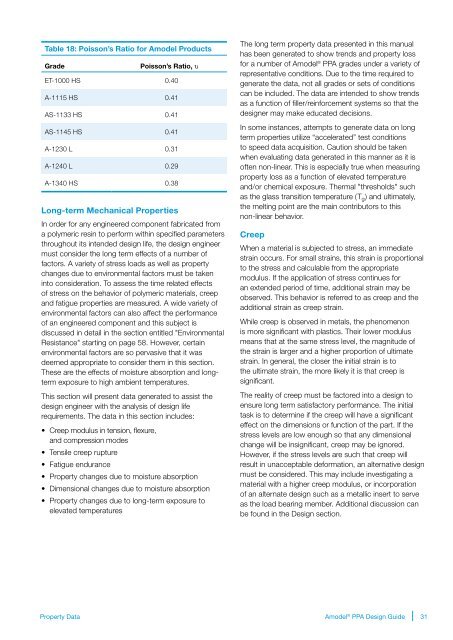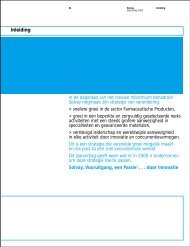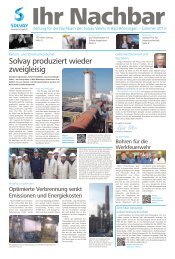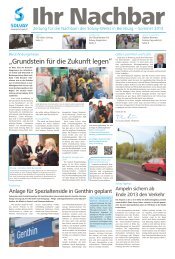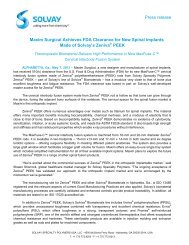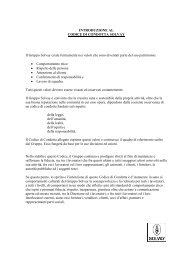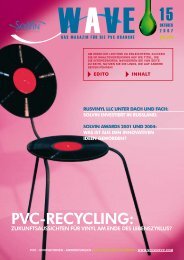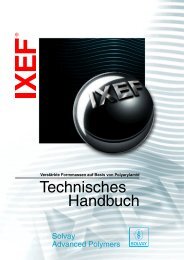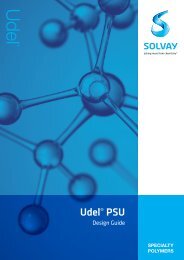Design Guide - Solvay Plastics
Design Guide - Solvay Plastics
Design Guide - Solvay Plastics
You also want an ePaper? Increase the reach of your titles
YUMPU automatically turns print PDFs into web optimized ePapers that Google loves.
Table 18: Poisson’s Ratio for Amodel Products<br />
Grade<br />
Poisson’s Ratio, υ<br />
ET-1000 HS 0.40<br />
A-1115 HS 0.41<br />
AS-1133 HS 0.41<br />
AS-1145 HS 0.41<br />
A-1230 L 0.31<br />
A-1240 L 0.29<br />
A-1340 HS 0.38<br />
Long-term Mechanical Properties<br />
In order for any engineered component fabricated from<br />
a polymeric resin to perform within specified parameters<br />
throughout its intended design life, the design engineer<br />
must consider the long term effects of a number of<br />
factors. A variety of stress loads as well as property<br />
changes due to environmental factors must be taken<br />
into consideration. To assess the time related effects<br />
of stress on the behavior of polymeric materials, creep<br />
and fatigue properties are measured. A wide variety of<br />
environmental factors can also affect the performance<br />
of an engineered component and this subject is<br />
discussed in detail in the section entitled "Environmental<br />
Resistance" starting on page 58. However, certain<br />
environmental factors are so pervasive that it was<br />
deemed appropriate to consider them in this section.<br />
These are the effects of moisture absorption and longterm<br />
exposure to high ambient temperatures.<br />
This section will present data generated to assist the<br />
design engineer with the analysis of design life<br />
requirements. The data in this section includes:<br />
• Creep modulus in tension, flexure,<br />
and compression modes<br />
• Tensile creep rupture<br />
• Fatigue endurance<br />
• Property changes due to moisture absorption<br />
• Dimensional changes due to moisture absorption<br />
• Property changes due to long-term exposure to<br />
elevated temperatures<br />
The long term property data presented in this manual<br />
has been generated to show trends and property loss<br />
for a number of Amodel ® PPA grades under a variety of<br />
representative conditions. Due to the time required to<br />
generate the data, not all grades or sets of conditions<br />
can be included. The data are intended to show trends<br />
as a function of filler/reinforcement systems so that the<br />
designer may make educated decisions.<br />
In some instances, attempts to generate data on long<br />
term properties utilize “accelerated” test conditions<br />
to speed data acquisition. Caution should be taken<br />
when evaluating data generated in this manner as it is<br />
often non-linear. This is especially true when measuring<br />
property loss as a function of elevated temperature<br />
and/or chemical exposure. Thermal "thresholds" such<br />
as the glass transition temperature (T g ) and ultimately,<br />
the melting point are the main contributors to this<br />
non-linear behavior.<br />
Creep<br />
When a material is subjected to stress, an immediate<br />
strain occurs. For small strains, this strain is proportional<br />
to the stress and calculable from the appropriate<br />
modulus. If the application of stress continues for<br />
an extended period of time, additional strain may be<br />
observed. This behavior is referred to as creep and the<br />
additional strain as creep strain.<br />
While creep is observed in metals, the phenomenon<br />
is more significant with plastics. Their lower modulus<br />
means that at the same stress level, the magnitude of<br />
the strain is larger and a higher proportion of ultimate<br />
strain. In general, the closer the initial strain is to<br />
the ultimate strain, the more likely it is that creep is<br />
significant.<br />
The reality of creep must be factored into a design to<br />
ensure long term satisfactory performance. The initial<br />
task is to determine if the creep will have a significant<br />
effect on the dimensions or function of the part. If the<br />
stress levels are low enough so that any dimensional<br />
change will be insignificant, creep may be ignored.<br />
However, if the stress levels are such that creep will<br />
result in unacceptable deformation, an alternative design<br />
must be considered. This may include investigating a<br />
material with a higher creep modulus, or incorporation<br />
of an alternate design such as a metallic insert to serve<br />
as the load bearing member. Additional discussion can<br />
be found in the <strong>Design</strong> section.<br />
Property Data<br />
Amodel ® PPA <strong>Design</strong> <strong>Guide</strong><br />
31


